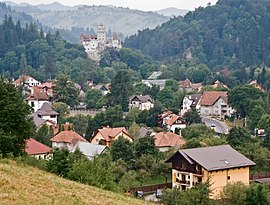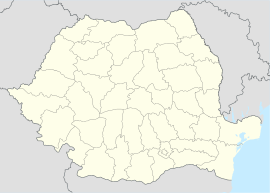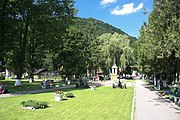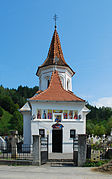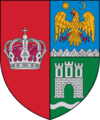
Transylvania is a historical and cultural region in Central Europe, encompassing central Romania. To the east and south its natural border is the Carpathian Mountains and to the west the Apuseni Mountains. Broader definitions of Transylvania also include the western and northwestern Romanian regions of Crișana and Maramureș, and occasionally Banat. Historical Transylvania also includes small parts of neighbouring Western Moldavia and even a small part of south-western neighbouring Bukovina to its north east.

Brașov is a city in Transylvania, Romania and the county seat of Brașov County.

Brașov County is a county (județ) of Transylvania, Romania. Its capital city is Brașov. The county incorporates within its boundaries most of the Medieval "lands" (țări) Burzenland and Făgăraș.

Predeal is a town in Brașov County, Muntenia, Romania. Predeal, a mountain resort town, is the highest town in Romania. It is located in the Prahova Valley, Muntenia at an elevation of over 1,000 m (3,300 ft). The town administers three villages: Pârâul Rece, Timișu de Jos, and Timișu de Sus. Predeal is twinned with Macugnaga, Italy.

Odorheiu Secuiesc is the second largest municipality in Harghita County, Transylvania, Romania. In its short form, it is also known as Odorhei in Romanian and Udvarhely in Hungarian. The Hungarian name of the town "Udvarhely" means "courtyard place".

Bran Castle is a castle in Bran, 25 kilometres (16 mi) southwest of Brașov. The castle was built by Saxons in 1377 who were given the privilege by Louis I of Hungary. It is a national monument and landmark in Transylvania. The fortress is on the Transylvanian side of the historical border with Wallachia, on road DN73.

The Bucegi Mountains are located in central Romania, south of the city of Brașov. They are part of the Southern Carpathians group of the Carpathian Mountains. At 2,505 m (8,219 ft), Omu is its highest point.

Romania's tourism sector had a direct contribution of EUR 5.21 billion to the Gross Domestic Product (GDP) in 2018, slightly higher than in 2017, placing Romania on the 32nd place in the world, ahead of Slovakia and Bulgaria, but behind Greece and the Czech Republic. The total tourism sector's total contribution to Romania's economy, which also takes into account the investments and spending determined by this sector, was some EUR 15.3 billion in 2018, up by 8.4% compared to 2017.

Prahova Valley is the valley where the Prahova river makes its way between the Bucegi and the Baiu Mountains, in the Carpathian Mountains, Romania. It is a tourist region, situated about 100 km (62 mi) north of the capital city of Bucharest.

Țara Bârsei is a historic and ethnographic area in Brașov County, southeastern Transylvania, Romania with a mixed population of Romanians, Germans, and Hungarians.
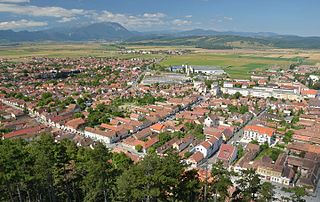
Râșnov is a town in Brașov County, Transylvania, Romania with a population of 15,920 as of 2021.

Rucăr is a commune located in the north-eastern part of Argeș County, Romania, situated in the Carpathian Mountains. The commune is composed of two villages, Rucăr and Sătic, and its population as of 2021 was 5,259. Historically important for its role as a border region between Wallachia and its neighboring countries, it is today popular with tourists from Bran Castle.
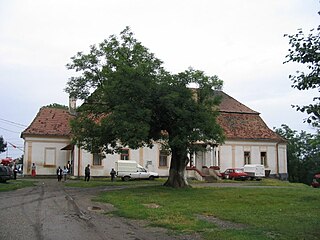
Voivodeni is a commune in Mureș County, Transylvania, Romania. It is composed of two villages, Toldal (Toldalag) and Voivodeni. The former village is much less populated than the latter.
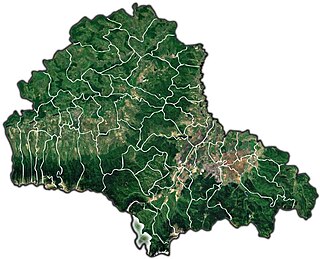
Fundata is a commune in Brașov County, Romania, in the historic region of Transylvania. It is composed of three villages: Fundata, Fundățica, and Șirnea. The place offers panoramas for the Piatra Craiului Mountains and Bucegi Mountains. During the 2013 European Youth Olympic Winter Festival, it held the biathlon competition in the new venue of the town.

Sâmbăta de Sus is a commune in Brașov County, Transylvania, Romania. It is composed of two villages, Sâmbăta de Sus and Stațiunea Climaterică Sâmbăta. Formerly part of Voila commune, these villages were split off to form a separate commune in 2003.
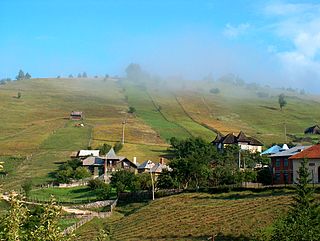
Dâmbovicioara is a commune in Argeș County, Muntenia, Romania. It is composed of three villages: Ciocanu, Dâmbovicioara, and Podu Dâmboviței.
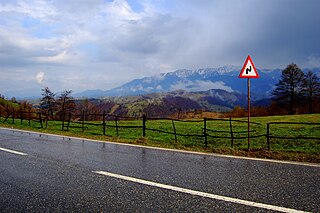
The Rucăr–Bran Pass, also called in English the Bran Pass, is a mountain pass in Romania, linking the counties of Brașov and Argeș. It has some of the most spectacular natural views in Romania, looking over the Bucegi Mountains of the Southern Carpathians.

Dracula tourism is a type of cultural tourism involving travel to sites associated with Dracula and his real or imaginary travels. There is Dracula tourism mainly in Transylvania, Romania.

Țara Făgărașului is a historical region in central Romania, located in the southern part of Transylvania. It is named after the Făgăraș Mountains that dominate the landscape of the area.
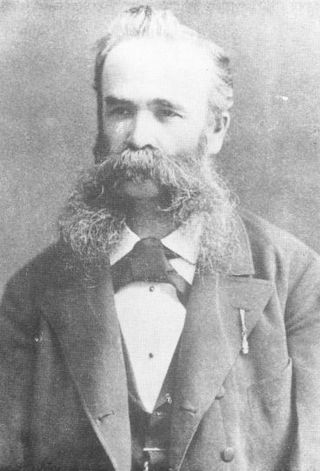
Ioan Pușcariu was an Austro-Hungarian ethnic Romanian historian, genealogist and administrator. A native of the Brașov area, he studied law until the 1848 revolution, when he took up arms. After order was restored, he embarked on a four-decade career in government that took him throughout his native Transylvania as well as to Vienna and Budapest. During the 1860s, Pușcariu was involved in the political debates of his province's Romanians, and also helped set up their key cultural organization, the Transylvanian Association for Romanian Literature and the Culture of the Romanian People (ASTRA). His historical interests lay primarily with the Transylvanian Romanians' nobility and their genealogy; Pușcariu's research into the subject secured his election to the Romanian Academy.
